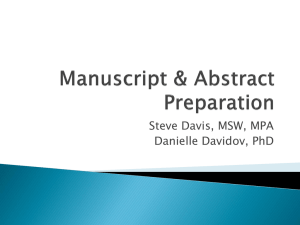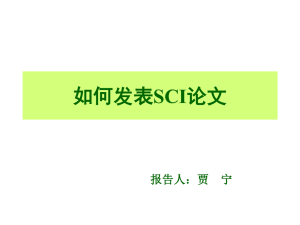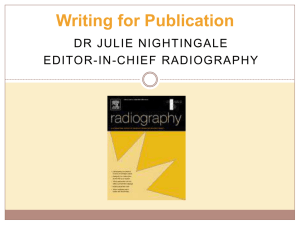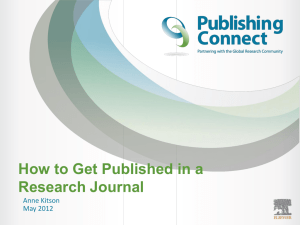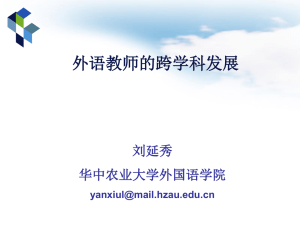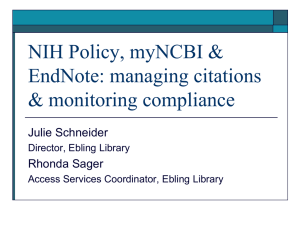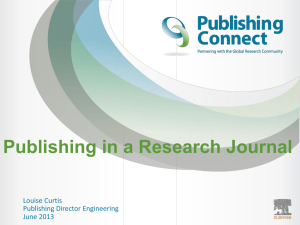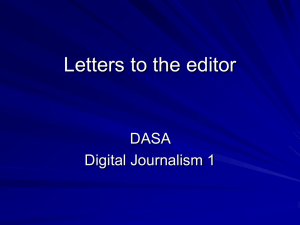2010521151320596
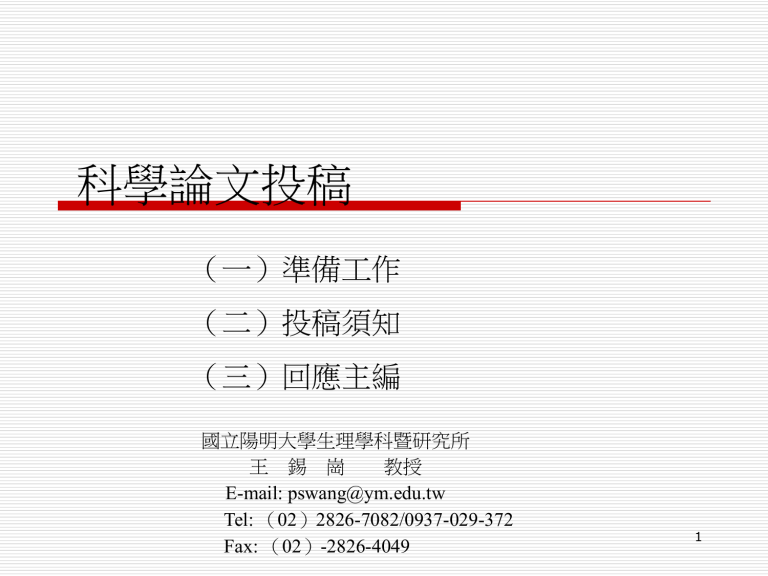
科學論文投稿
(一)準備工作
(二)投稿須知
(三)回應主編
國立陽明大學生理學科暨研究所
王 錫 崗 教授
E-mail: pswang@ym.edu.tw
Tel: ( 02 ) 2826-7082/0937-029-372
Fax: ( 02 ) -2826-4049
1
Ref: How to Write and Publish a
Scientific Paper
— 6th Edition ©2006
— by Robert A. Day and Barbara Gastel
Cambridge University Press
2
(一)準備工作
How to Prepare a Scientific Manuscript for Submission
I. How to Prepare a Manuscript ?
1. What do I have to say? What is my hypothesis?
2. Is the paper worth writing? What is the rationale?
3. What is the right format for the message? Data ready?
4. Who will be reading the message?
5. Which is the right SCI journal for the manuscript?
3
II. Process
Three Steps:
Step 1. Decision of Authorship.
Step 2. Read the Manuscript Requirements of the Journal.
Step 3. Collect Research Data.
4
My Experience:
1. Confirm the Journals: Make the Priority
2. Read the “Instructions to Authors” Carefully
3. Collect the Sample Copies: (1) The Journal Paper
(2) Manuscript
4. Title Page: Temporary
5. Preparation of Data: (1)How to Select and Make Order
(2)Table and Figure Legends
6. Collection of References: Updated; Number Limitation
7. Materials and Methods
5
8. Results
9. Discussion (& Conclusion)
10. Introduction
11. Abstract
12. Acknowledgments
13. Footnotes
14. Title Page (To Confirm: Senior Author ?
Corresponding Author ? )
15. Cover Letter
6
III. English Editing
1. Self-Correction: Typing Errors, Grammatical Errors,
Spelling Errors, etc.
2. Assistance Provided by Experts:
(1) Payment: How Much?
(2) Time: How Long?
7
IV. Immediately before Submission
If: Rejected ? Major Revision ? Minor Revision ?
8
(二)投稿須知
How to Submit a Manuscript to a
Scientific Journal
?
9
I. How to Select an Optimal (Proper) Journal?
1. Category (Field)
2. Impact Factor (2-year, 5-year)
3. Rank
4. Periodical
5. Cost : Submission Fee? Page Charge? Publication
Fee? Reprint Fee? Color Page Charge?
6. Editor-in-Chief, Associate Editor, (Example: AJP…)
10
II. Paper Submission or On Line Submission
11
Checking Your Manuscript
Double space.
Use margins of ~ 2 cm.
Left-justify the text; leave a “ragged” right margin.
Start each section of the manuscript on a new page.
The title and the author’s names and addresses are usually on the first page, which should be numbered 1. The Abstract is on the second page, the
Introduction starts on the third page…..
—— Day & Gastel, How to Write and Publish a Scientific Paper
(6th Ed, 2006)
12
III. How to Write a Cover Letter ?
1. To Whom? Editor-in-Chief? Associate Editor?
2. Text: Title & Authors
3. Originality
4. Corresponding Author
5. Others
6. Examples
13
In the Cover Letter or
On the Title Page —
Corresponding Author:
Name, Address (Affiliation),
Telephone Number,
Fax Number,
E-mail Address
14
To recommend or suggest the appropriate editor (in multieditor journals) and reviewers (names, addresses, Tel No., Fax
No., E-mails)
15
Dear Dr. Wang.
Enclosed please find a manuscript entitled “THE ….EFFECT ….. OF
GLOBAL SYNKINESES IS EFFORT DEPENDENT” by I.S. Huang, C. F.
Lin, Y.C. Chen, C.Y. Cho. and C.H. Wang with three copies are submitted for publication in the CHINESE JOURNAL OF PHYSIOLOGY . The material presented in manuscript is original and has not been submitted for publication elsewhere.
Please address all correspondence concerning the manuscript to Mr. C-H.
Wang, School of Physiology Therapy, College of Medical Technology,
Chung Shan Medical University, Taichung 402, Taiwan, Republic of China.
Sincerely Yours,
C.H. Wang, Associated Professor
16
Ⅳ.
How to Deal with Editors?
17
Great Journals are born in the hands of the editors; they die in the hands of businessmen.
- Bernad De Voto
18
What the Author Expects from the Editor
----- accept all my manuscripts,
----- scrutinize all others.
19
Editor, Editor-in-Chief, Chief Editor:
— a scientist of preeminent standing,
— designates the peer reviewers
— makes final decisions
Associate Editors:
Managing Editors:
Assistant Editors:
Copyeditors: editing, wording, correct errors in grammars, spelling, punctuation, and usage.
20
Unpaid Volunteer Scientists
Full-time Paid Professional Experts
(or Staff Members)
21
Preacceptance Problems Editor
(or Editor-in-Chief)
Postacceptance Problems Managing Editor
Queries Copyeditor or -----
22
Preliminary Decisions
Preconditions
23
Ⅴ .
Wait for Decision: Ask about Current Status
Dear Editor,
I wish to know the current status of my manuscript
(No.________) entitled “…..” which had been submitted to you ten weeks ago.
Sincerely yours,
Author’s name
24
Ⅵ.
How to Respond to Editor’s and Reviewers’
Comments
25
(三)回應主編
How to Respond to the Editor’s
Decision
?
26
Peer Review System and Anonymous Reviewers
Deleting author’s names from the copies of manuscripts
27
1. The Criteria for Decision-Making
(1) Relevance of the manuscript to the journal’s scope and readers.
(2) Importance of the manuscript’s message to most of the journal’s readers.
(3) Newness of the paper’s message.
(4) Scientific validity of the evidence supporting the paper’s conclusions.
(5) Usefulness of the paper to the journal in maintaining a satisfactory distribution of topics.
(6) The journal’s backlog of accepted manuscripts.
(7) Quality of the presentation in the manuscript (good or poorly written).
(8) Grammatical evaluation.
(9) Others (e.g. multiple publication; re-publication: for selfish motives).
28
The Editor’s Decision: Three General Types
Accept -----
Modify -----
Reject -----
29
Don ’ t Challenge the Chief-Editor :
(1) Don ’ t blame chief-editor ...
- You must not blame me for that,
It was not my fault.
Don ’ t ask chief-editor to take on it...
(2) Don ’ t ask the reviewers ’ names...
30
31
32
33
34
主編心思之探討
Try to Understand the Chief-Editor
:
(1)Manuscripts?
(2)Reviewers?
(3)Make Friends or Make Enemies?
35
2. A Copy of the Review Form from CJP
36
37
38
39
3. A Copy of the Review Form from AJP
40
41
42
4. A Copy of the Review Form from Life Science
43
… et al.
44
45
46
5. Time Needed for Making a Decision
(1) Immediate rejection
(2) Acknowledgment for receiving manuscript (with MS#)
(3) Ask for agreement for reviewing
(4) Sent to reviewers or consultants for reviewing: 2-4 Weeks
(5) Ask the third reviewer for reviewing: 2-4 Weeks
(6) Making the decision
(7) How to ask the current status of manuscript (a sample letter) ? Eight weeks after receiving acknowledgment letter.
47
6. Good News
(1) Unconditional acceptances: no explanation, no revision.
(2) Acceptances with minor revision:
Correction for spelling and/or grammatical errors
Improving illustrations
Restructuring tables
Eliminating unmeaningful statements
Shortening text
Other changes (e.g. format)
(3) How to refuse to do revisions ? Reply by letter to the editor about the difficulties you have in revising the manuscript along lines requested and why.
48
7
. Revision
Major Revision
Miner Revision
Editor’s Deadline
49
8.
When Required to Make a Major Revision
(1) Do not simply ignore the reviewers’ comments and the editor’s decision letter and return the paper unchanged.
(2) Do your best to revise the manuscript without delay along the line suggested by the reviewers and requested by the editor.
(3) If suggestions or comments from reviewers are contradictory, …
(4) Not all suggestions or comments from reviewers may have to be accepted, but you will have to …
50
9. Returning a Revised Manuscript
(1) A cover letter
(2) Send with revised manuscript and a letter not only identifying it as a new version but also specifying exactly what changes have been made. Underlined or marked the correction or changed portions in your revised manuscript.
51
10. Rejection ?
(1) The manuscript can not be accepted at the present form, if you…
(2) Rejected, but encouraged to resubmit a new version…
52
Rejections of 4 Ways:
(1) Total rejection
(2) Reconsider if -----
(3) A defect or defects: This manuscript is unacceptable (or can not be acceptable) in the present form-----
(4) In highly competitive journals, although…, the manuscript is not important enough or of broad enough interest-----
53
Resubmitting your manuscript to the same journal or another journal after correction.
54
Dear Dr. Pu:
Thank you for submitting your manuscript entitled:
“Mechanisms of Digitoxin on the Production of Corticosterone in Zona
FasciculataReticularis Cells of Ovariectomized Rats” to the Journal of Cellular
Biochemistry. Below you will see the comments of the reviewer. I share the substantial concern and reservation, and am unable to accept the manuscript in its present form.
However, if you resubmit the manuscript after making the suggested changes, I will reconsider it for publication. This submission will be assigned a new number, and will be considered a new submission. Please reference this paper in your cover letter with the reworked manuscript.
We want to thank you for sending your manuscript to us for consideration.
Please let us know if you require any of your materials returned (we will keep one original for our records).
We do hope to see your work again, and look forward to perhaps publishing it at some point in the future.
Sincerely,
Dr.
Executive Editor
55
56
57
58
59
60
61
62
63
11. Rejection!
(1) Rejection rate: 30 %, 50 %, 70 %, 90 %
(2) Bad news: to carry at least one reason for rejection.
(3) Do not get angry.
(4) Consider carefully the comments from the reviewers: to improve your manuscript greatly.
(5) After correction, send to another journal; as soon as possible.
(6) The possibility that the reviewers who will read the manuscript for the second journal may include one or more of the reviewers who read it for the first journal,..
(7) Send a clean and reformate manuscript to the second journal: bearing no marks, no restapling holes, no other marks… be sure that the manuscript looks as if it has been prepared specifically for the second journal.
(8) Do not give up efforts to make it published.
64
12. How to Deal with Proofs
Proofing Process: Copyright’s work
Author queries
Author should examine the proofs carefully
Misspellings: Read, study, catch errors of omission
Additions of References: New 21a between
21 and 22.
65
Tang et al.,
Experientia 42:
1031-1034, 1986
66
Marking the Corrections Proofreader’s
Marks
67
(Neuroendocrinology)
68
(Neuroendocrinology)
69
Transfer Copyright with Cover Letter:
1.
If my manuscript includes all materials that have been published elsewhere.
2.
Transfer the copyright for my manuscript to the journal.
70
Copyright
Copyright protects original forms of expression but not the ideas being expressed.
Day & Gastel,
How to Write and Publish a
Scientific Paper (6th Ed, 2006)
71
Copyright is divisible .
Copyright can be transferred.
— get permission from the copyright owner.
- Day & Gastel,
How to Write and Publish a
Scientific Paper (6th Ed, 2006)
72
In the absence of a written transfer of copyright, the publisher is presumed to have acquired only the privilege (special right) of publishing the article in the journal itself; the publisher would lack -----
- Day & Gastel,
How to Write and Publish a
Scientific Paper (6th Ed, 2006)
73
Copyright and Electronic Publishing
Unless the author or owner of the copyright of work posted on the Internet has placed on that work a specific note stating that the item is in the public domain, it is under copyright and you may not reproduce it without permission.
- Day & Gastel,
How to Write and Publish a
Scientific Paper (6th Ed, 2006)
74
e.g. “ Copyright 2007 by Paulus S. Wang
( or Yang-Ming Press ) ”
75
13.
General Criteria for An Editor to Make Decision
76
一般主編最不喜歡的稿件:
(一) 抄襲,違反學術倫理
(二) 不符合期刊格式
(三) 無法連絡作者
(四) 無人願審稿
(五) 數據貧乏
(六) -----
77

